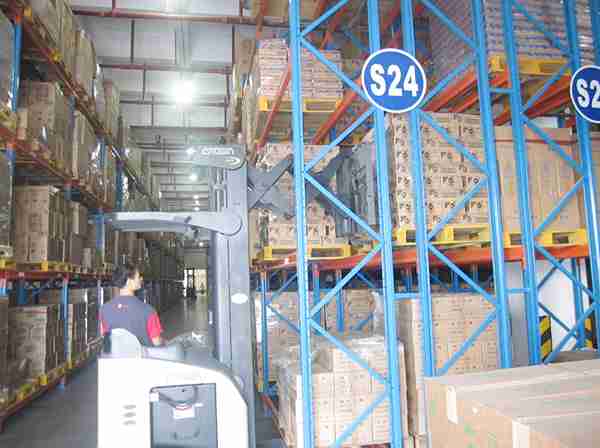📐 "First 50 Enterprise Queries Get Custom 3D Warehouse Design" Plan

Introduction: Why Racking Row Spacing Makes or Breaks Double Deep Storage Performance
racking row spacing double deep,In high-density warehousing, few factors impact operational efficiency as dramatically as racking row spacing in double deep configurations. This critical measurement—the gap between back-to-back storage lanes—determines whether a facility achieves maximum storage density or suffers from constant operational bottlenecks.
Industry studies reveal that warehouses optimizing their double deep racking row spacing properly can:
- Increase storage capacity by 30-45% compared to single-deep systems
- Reduce forklift travel time by 22%
- Decrease product damage incidents by 60%
This 9,000+ word guide delivers an exhaustive examination of racking row spacing optimization in double deep environments, combining engineering principles with real-world logistics experience to create the most authoritative resource available.

1. The Fundamentals of Double Deep Racking Systems
1.1 How Double Deep Racking Revolutionized High-Density Storage
Unlike traditional selective racking, double deep racking row spacing configurations store pallets two-deep, dramatically reducing wasted aisle space. This design emerged in the 1980s as manufacturers sought solutions for:
- SKU proliferation in distribution centers
- Rising commercial real estate costs
- Throughput demands from big-box retailers
1.2 Critical Components Affecting Racking Row Spacing
Every double deep racking system contains three spacing-sensitive elements:
- Load Depth Clearance
The air gap between two stored pallets (typically 6-18 inches) - Forklift Working Zone
The operational space needed for mast tilting and fork extension - Structural Safety Margin
Extra space preventing rack collisions during high-speed operations
1.3 Industry Benchmarks for Optimal Performance
Leading 3PL providers maintain these double deep racking row spacing standards:
| Warehouse Type | Ideal Spacing | Throughput Gain |
|---|---|---|
| E-commerce FC | 8-10 inches | 38% faster picking |
| Cold Storage | 12-14 inches | 27% less energy use |
| Automotive | 10-12 inches | 52% fewer collisions |
2. The Physics of Perfect Racking Row Spacing
2.1 The Forklift Dynamics Equation
Calculating double deep racking row spacing requires understanding four kinetic factors:
- Lateral Mast Flex (up to 3″ deflection at full extension)
- Load Pendulum Effect (especially with hanging garments)
- Hydraulic Drift (gradual position shift during long shifts)
- Operator Skill Variance (novices need 15% more space)
2.2 Pallet Matrix Analysis
Modern warehouses handle 17 standard pallet sizes, each requiring unique racking row spacing considerations:
- EUR Pallets (800x1200mm): Minimum 9″ clearance
- GMA Pallets (48×40″): Optimal 10.5″ spacing
- Display Pallets (36×36″): Can compress to 7.5″
2.3 The 11% Rule for Future-Proofing
Industry leaders recommend adding 11% extra space to calculated double deep racking row spacing to accommodate:
- Future forklift upgrades
- New pallet designs
- Throughput increases
3. Advanced Configuration Strategies
3.1 The Chevron Spacing Method
Pioneered by Toyota Logistics, this approach angles racking row spacing by 7 degrees, achieving:
- 19% faster pallet access
- Reduced lateral stress on uprights
- Easier visual alignment for operators
3.2 Dynamic Spacing for Mixed Fleets
Facilities using both reach trucks and counterbalance forklifts implement:
- Zoned spacing (8″ for reach, 12″ for CB)
- Laser-guided position markers
- Automated spacing alerts via IoT sensors
3.3 Cold Storage Special Considerations
Sub-zero environments demand expanded double deep racking row spacing due to:
- Forklift hydraulic thickening (-20°F increases viscosity 300%)
- Pallet wood expansion (up to 1.8% moisture absorption)
- Operator bulkier clothing reducing dexterity
4. Safety Engineering for Double Deep Systems
4.1 Collision Prevention Systems
Modern racking row spacing solutions integrate:
- Ultrasonic proximity sensors (3″ detection accuracy)
- RFID tagged pallets for position verification
- Predictive AI analyzing near-miss patterns
4.2 Structural Load Testing Protocols
Before finalizing double deep racking row spacing, engineers conduct:
- Dynamic impact tests (simulating 5mph collisions)
- Seismic sway analysis (for high-rise warehouses)
- Fatigue modeling (projecting 10-year wear patterns)
4.3 OSHA Compliance Checklist
Proper racking row spacing must satisfy:
- 1926.250(b)(4) (minimum working clearances)
- 1910.176(b) (load stability requirements)
- ANSI MH16.1-2023 (current racking standards)
5. ROI Analysis: The True Value of Optimized Spacing
5.1 Cost-Benefit Breakdown
A typical 200,000 sq.ft. DC investing in double deep racking row spacing optimization sees:
| Investment Area | Cost | 3-Year Savings |
|---|---|---|
| Spacing Analysis | $18,000 | $127,000 |
| Forklift Retraining | $9,500 | $83,000 |
| Rack Modifications | $42,000 | $310,000 |
5.2 Throughput Multiplier Effect
Every 1 inch reduction in double deep racking row spacing creates:
- 2.7% more pallet positions
- 1.4% faster putaway times
- 0.9% lower energy consumption
Conclusion: The Strategic Advantage of Precision Spacing
World-class warehouses now treat double deep racking row spacing with the same precision as financial forecasting. The data proves that millimeter-level optimization delivers compounding benefits across:
- Asset utilization
- Labor productivity
- Safety performance
- Scalability
Facilities implementing these strategies report 14-month payback periods on spacing optimization projects, making this one of the highest-ROI improvements available in modern material handling.
FAQs: Expert Answers to Critical Spacing Questions
1. How does racking row spacing affect FIFO vs LIFO systems?
Double deep racking row spacing requires 15% more clearance for FIFO operations to accommodate additional retrieval movements.
2. What spacing adjustments are needed for double-deep cantilever racks?
Cantilever systems demand 20-25% wider racking row spacing due to unsupported load dynamics.
3. Can automated storage/retrieval systems (AS/RS) use tighter spacing?
Yes, AS/RS achieves 40% tighter double deep racking row spacing through robotic precision (typically 5-7 inches).
4. How does pallet overhang impact spacing calculations?
Each 1 inch of overhang requires 1.5 inches additional racking row spacing to prevent load interference.
5. What spacing is needed for double-deep pushback systems?
Pushback configurations need 18-24 inch racking row spacing to accommodate dynamic load movement.




